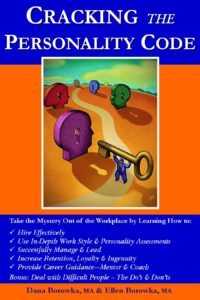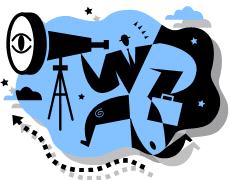Excerpt from Cracking The Personality Code book
How to Become a Vision-Focused Leader
[dropcaps type=”circle” color=”” background=””]T[/dropcaps]he answer is leadership. It is time to become a vision-focused leader around whom issues can be raised and resolved productively. That’s the view of Suzanne and Dwight Frindt, the founders of 2130 Partners, a leadership development and education firm that facilitates focused vision, inspired teams, and sustained commitment for its clients.
Ask yourself these questions:
• Are your conversations with your team generating the results you want?
• Does your team successfully raise and resolve issues relevant to business success?
• Can you identify and deal with emotional upsets, in both yourself and others?
Exactly what is this leadership that is vision-focused? “We love Warren Bennis’ definition: ‘Leadership is the wise use of power. Power is the capacity to translate intention into reality and sustain it,’” says Suzanne Frindt. “Our approach is the same whether we are working with individuals or with en-tire leadership teams. We believe the greatest opportunities are created by the development of people and action in a coordinated direction. We assert that the only sustainable strategies engage the heart and soul and are simultaneously grounded in sound business practices.”
Suzanne Frindt co-founded 2130 Partners with her husband Dwight in 1990. She is a recognized speaker on the topics of Vision-Focused Leadership™ and Productive Interactions™(www.2130partners.com), speaking to various organizations around the world. Suzanne is also a group chair for Vistage International, Inc., an organization dedicated to increasing the effectiveness and enhancing the lives of more than 14,000 CEO and executive members in sixteen countries.
Dwight Frindt established 2130 Partners on an idea that has become the cornerstone of the firm. The guiding methodology of Vision-Focused Leadership was born from his years of hands-on executive experience and from his thirty-year affiliation with The Hunger Project, an organization committed to the sustainable end of world hunger. Dwight has integrated his knowledge of managing operations, acquisitions, and turn-arounds with insights he has learned through the work of The Hunger Project in rural villages around the world. Dwight also serves as a group chair for Vistage International and monthly facilitates CEO and executive groups in Orange County, California.
In their leadership programs, through their firm 2130 Partners, the Frindts train participants to utilize a new paradigm and methodology to shift the way they listen and dialogue. This critical approach enhances fundamental skills and abilities to have successful interactions—the corner-stone of effective leadership.
Power of Shared Vision
In a 1996 article in the Harvard Business Review entitled “Building Your Company’s Vision,” Jim Collins and Jerry Porras said that companies that enjoy enduring success have a  core purpose and core values that remain fixed while their strategies and practices endlessly adapt to a changing world. The rare ability to balance continuity and change—requiring a consciously practiced discipline—is closely linked to the ability to develop a vision.
core purpose and core values that remain fixed while their strategies and practices endlessly adapt to a changing world. The rare ability to balance continuity and change—requiring a consciously practiced discipline—is closely linked to the ability to develop a vision.
Vision provides guidance about what to preserve and what to change. Suzanne Frindt calls vision a “Yonder Star.”
“Without a vision, what is the point?” says Suzanne Frindt. “A Yonder Star unleashes the energy to galvanize yourself and your employees so you can achieve phenomenal things.”
When group members share a vision, it creates an opportunity for totally different conversations between a manager and members of their team. Focus on the shared vision creates alignment and provides a powerful context for creating mission, strategic initiatives, objectives, goals, roles, and finally all the way down through action plans.
Being a manager means making choices. At any moment in time you have a decision to make. Suzanne urges that when it comes time to make a decision being present in the moment, not on automatic pilot, is essential to the quality and relevance of the decision. You can then make the choice based on your Yonder Star, your shared vision of something to which you aspire, versus more of the same or your fear of some worst-case scenario.
“Worries are about envisioning a worst-case scenario, what you fear most,” says Suzanne Frindt. “Whatever we envision is affecting us right now. What we envision impacts us in this moment. There are consequences for managing based on fears that you may not want. Your Yonder Star is the shared vision you aspire to. The star is what you envision, and what you envision shapes both the present moment and the quality of your choices about your actions.”
Something else she recommends avoiding is being past-focused. This is when you make decisions based solely on what you have done in the past. Instead of having an inspiring vision for your team, all you are working for with a past based focus is attempting to minimize perceived risk and making incremental improvements.
“Many companies are past-focused when they do strategic planning,” says Suzanne Frindt. “What did the company do last year and then let’s add 10 percent or 20 percent. We are all tempted to try hard to make yesterday look like today. Or if we didn’t like yesterday, then we try to make it different or better.”
She adds that only by having a vision, a Yonder Star, can teams create breakthroughs to unprecedented results. Equally important is that it is a shared vision, one that is based on shared values and shared operating principles. This is how you create an environment for real collaboration.
The Frindts also advise their clients to learn to shift from being monologuers to dialoguers. As Margaret Miller once said, “Most conversations are simply monologues delivered in the presence of witnesses.” A monologuer manager is driven by proving they are right rather than engaging in a conversation for creative problem solving. This monologuing manager often gets surrender and appeasement from their team members rather than enthusiastic engagement.
Dialogue is the opposite. The three Cs of dialoguing are connect, con-verse and create. It has been said that the purpose of dialogue is not to share information but to create information. The focus is on the issue and your shared purpose rather than each other. As a manager, your ability to model and encourage listening that is curious and open dramatically increases your effectiveness. The dimensions that become possible are creativity, connection, alignment, focus, and collaboration.
“You create your vision, honestly assess where you are, and then get to work on the gap,” says Suzanne Frindt. “On the road there will be road-blocks and potholes. As a manager you work with your team to get around the roadblocks and fill in potholes.”
Overcoming Emotional Barriers
“The ability to identify and clear upsets, in myself and others, is the single most significant key to productivity gains in our economy today,” says Dwight Frindt. “We have asked our executive-leadership clients a simple question: ‘What time could you go home if everyone in the company simply came to work, did their jobs, and went home?’ The answer used to  surprise us until it kept being repeated. On average, our clients say, ‘Between 10:30 a.m. and 11:00 a.m.’”
surprise us until it kept being repeated. On average, our clients say, ‘Between 10:30 a.m. and 11:00 a.m.’”
That begs a second question. If so many executives claim they could go home before lunch if everyone just showed up and did their work, what’s taking so much of our leaders’ time? The Frindts’ clients tell them flat out: distress, commonly known as upsets. The most time-consuming part of their job is managing the distressed interactions within their teams so that those teams can actually get to the business at hand.
“Okay, let’s assume there’s gross exaggeration at play here, fueled by frustration and wry humor,” continues Dwight Frindt. “But even if executives will never be able to consistently leave by noon, it is entirely reason-able for them to expect to save at least two hours of their time, every day. Alternatively they could increase their productivity 15–30%”
That’s nearly 500 extra hours a year leaders can devote to creative thinking, visioning, and strategizing rather than on repairing relationships and soothing bruised egos. At the opportunity cost of most executives’ time, that amounts to very substantial savings. Of course, the same can be said for everyone in the organization. An inordinate amount of productive time and payroll dollars and worse yet, opportunities, are lost daily, monthly and annually to the distraction caused by unresolved emotional distress.
Replacing that time, energy, and resource loss is of paramount importance. Doing so can create a culture that is both highly productive and emotionally resilient and rewarding. It requires a fundamental, transformative shift in two steps: 1) fewer emotionally driven issues in the workplace; and 2) leaders and their team members becoming self-sufficient in handling emotional distress issues when they occur.
“Let’s clarify what we mean by emotional distress,” says Dwight Frindt. “We’re using the term to summarize a wide range of reactions that temporarily disable people with regard to thoughtful and productive behavior. These reactions can vary from mild frustration to full-blown anger, and include embarrassment, sadness, impatience, agitation, worry, and fear. In each case the person is left in a condition where, whether realized or not, they are acting as if their very survival is threatened.”
The Causes of Emotional Distress
The Frindts’ studies and their clients’ experiences make it clear that the most common root causes of workplace emotional distress are 1) the perception that a promise has been broken (usually by leadership); 2) when positive intentions “fail”; and 3) when commitments seem thwarted. In addition to these three internal triggers, there are many times when  personal distress is brought to the workplace from the rest of the person’s life. These other sources can be especially difficult to address, due to varying perspectives on what constitutes personal-professional boundaries.
personal distress is brought to the workplace from the rest of the person’s life. These other sources can be especially difficult to address, due to varying perspectives on what constitutes personal-professional boundaries.
The impact on the productivity and organizational effectiveness of people attempting to work while “stressed out” (or surrounded by others who are) is enormous. Yet it’s been the Frindts’ observation that most leaders overlook this as the place to start any efforts in business improvement. Most are far more comfortable with cost cutting, process development, process improvement, reorganizing, or some other business change that does not directly address the human dimension.
To help disarm this apparent reluctance to actively engage when emotional distress is present, the Frindts began several years ago to bring their clients a variety of expert presentations, books, and other training opportunities for building communication and issue-resolution skills. Even though there are many excellent resources available in this field, they were disappointed in the results. Their clients’ progress after exposure to all this material fell significantly short of what had been anticipated. The clients’ ability and skill in powerfully addressing emotional, distressing situations didn’t dramatically change.
So what went wrong? Why didn’t all that training and exposure to skill-building help when emotional distress was triggered? The problem is not in the content of the material. It’s in the limitation of its focus. Most of this highly regarded material addresses and is received by the intellectual part of the mind. That’s fine, as far as it goes, but too often the audience comes away with a conceptual understanding while gaining little or no real skill at changing behavior. Providing access to new information and a broader intellectual understanding is a good start, but it’s only a start. The Frindts found that unless this information is somehow deeply absorbed and embodied beyond the intellect, it vanishes when people are challenged and faced with intense emotion—their own or that of others.
In part two of this article, we will provide further ideas as well as the “5-Step Recipe” for identifying and dealing with emotional distress that can prevent vision-focused leadership.
Permission is needed from Lighthouse Consulting Services, LLC to reproduce any portion provided in this article. © 2014 This information contained in this article is not meant to be a substitute for professional counseling.
Suzanne Frindt is a co-founder and principal of 2130 Partners, an executive leadership development and education firm that launched in 1990. She is also a recognized speaker on the topics of Vision-Focused Leadership™ and Productive Interactions™, speaking to organizations around the world. She is also a Group Chair for Vistage International, Inc. an organization of CEOs and key executives dedicated to increasing the effectiveness and enhancing the lives of more than 12,000 members. Each month she facilitates groups in Orange County, California, and Seattle, Washington, while also regularly contributing entrepreneurial creativity and management experience to several companies through service on their advisory boards.
Dwight Frindt is also a co-founder and principal of 2130 Partners. Since 1994, Dwight has been a Group Chair for Vistage International facilitating groups of CEOs and senior executives. He has received many performance awards for his work at Vistage and in 2009 Dwight became a Best Practice Chair and began mentoring the Chairs in the South Orange County area. Since then he has added two additional Best Practice Chair regions; the Puget Sound and the Greater Pacific Northwest. In 2011 Dwight received the Best Practice Chair of the Year Award – Western Division. Combining his work with 2130 Partners and Vistage, Dwight has facilitated more than 1,000 days of workshops and meetings, and has logged well over 13,000 hours of executive leadership coaching.
In addition to working in the for-profit world, Dwight and Suzanne are very committed to working with non-profits and have been investors and activists with The Hunger Project for many years. To reach them please visit www.2130partners.com.
If you would like additional information on this topic or others, please contact your Human Resources department or Lighthouse Consulting Services LLC, 3130 Wilshire Blvd., Suite 550, Santa Monica, CA 90403, (310) 453-6556, dana@lighthouseconsulting.com & our website: www.lighthouseconsulting.com.
Lighthouse Consulting Services, LLC provides a variety of services, including in-depth work style assessments for new hires & staff development, team building, interpersonal & communication training, career guidance & transition, conflict management, 360s, workshops, and executive & employee coaching. Other areas of expertise: Executive on boarding for success, leadership training for the 21st century, exploring global options for expanding your business, sales and customer service training and operational productivity improvement.
To order our books, “Cracking the Personality Code” and “Cracking the Business Code” please go to www.lighthouseconsulting.com.
 It was the “hard work” that was the problem. Not the actual work: Jack worked 12–14 hour days. The problem was that Jack only had so many hours in a day. He could not get all the work done. So he decided to hire an office assistant to take tasks off his back and free up time to go after the big bucks.
It was the “hard work” that was the problem. Not the actual work: Jack worked 12–14 hour days. The problem was that Jack only had so many hours in a day. He could not get all the work done. So he decided to hire an office assistant to take tasks off his back and free up time to go after the big bucks.
 The book will talk about the details related to using a testing instrument in hiring. In creating a lead-in for this discussion, my observations are as follows:
The book will talk about the details related to using a testing instrument in hiring. In creating a lead-in for this discussion, my observations are as follows:






















